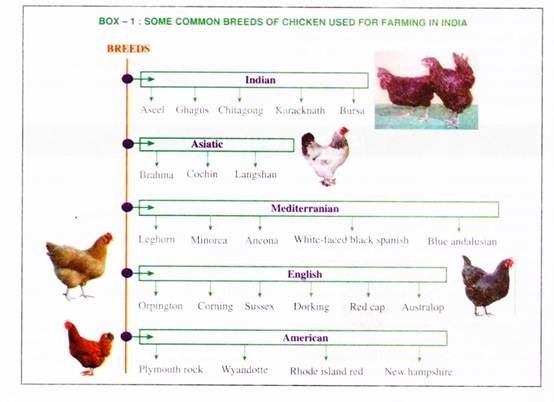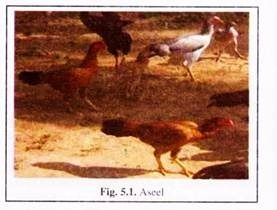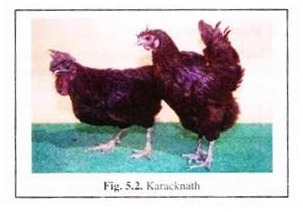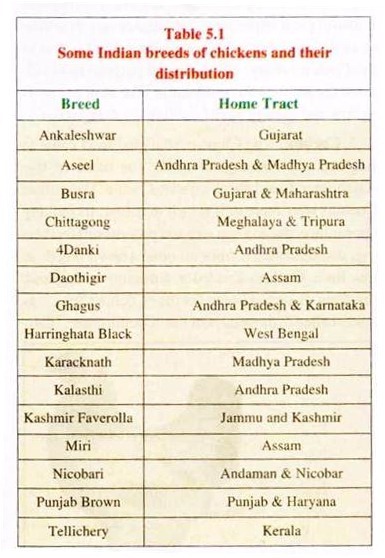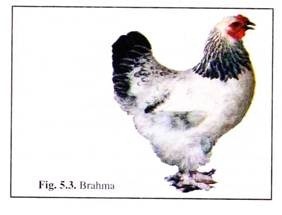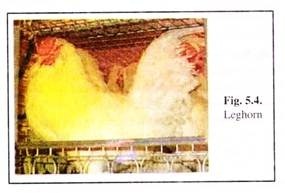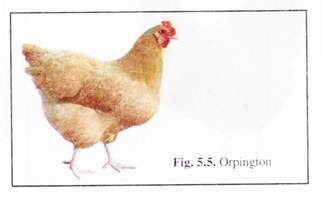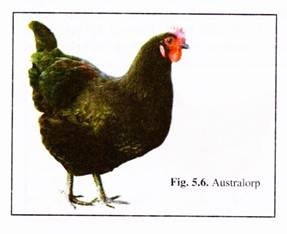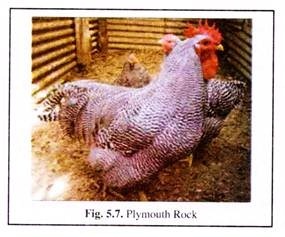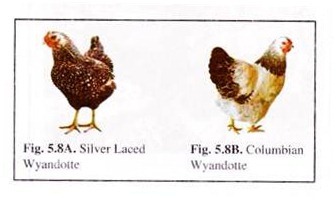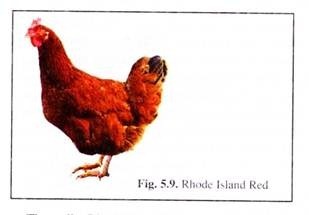List of common breeds of fowl that is used for farming in India:- 1. Indian Breeds 2. Asiatic Breeds 3. Mediterranean Breeds 4. English Breeds 5. American Breeds.
1. Indian Breeds:
A. Aseel (Fig. 5.1):
The literal meaning of Aseel is real or pure. Aseel is well-known for its pugnacity, high stamina, majestic gait and dogged fighting qualities. The name Aseel appears to have been given to this indigenous breed because of its inherent qualities of fighting. Andhra Pradesh is said to be the home of this important breed.
ADVERTISEMENTS:
The best specimen of this breed, although rare, is encountered with the fanciers and the people engaged in cock-fighting show throughout the country. Aseel is larger in built with noble looking and dignified appearance. The standard weight varies from sexual maturity, i.e., 196 days. Number of annual egg production is 92.
B. Ghagus:
It is a pure Indian breed having feathers on the legs. It is a big and hardy breed found in Andhra Pradesh and Karnataka. This is a good table bird. The hen is a fair layer, good sitter and a real mother.
ADVERTISEMENTS:
C. Chitagong or Malay:
This is a native bird of Malay Peninsula and breed in Chitagong district of Bangladesh. Now it is also found in some parts of Eastern India. The colour of this bird is white with splash of golden markings on the wing. This bird grows faster and is ideal for table purposes. Its flesh is excellent in taste.
D. Karacknath (Flesh is black in colour):
The original name of the breed seems to be Kalamasi, meaning a fowl with black flesh. However, it is popularly known as Karaknath (Fig. 5.2). Jhabua and Dhar districts of Madhya Pradesh and the adjoining districts of Rajasthan and Gujarat spreading over an area of about 800 sq. miles, is considered to be its home tract.
ADVERTISEMENTS:
These are mostly reared by tribals, adivasis and rural poor. It is considered to be a sacred bird and offered as sacrifice to Goddess after Diwali. The eggs are light brown in colour. The day-old chicks are bluish to black with irregular dark stripes over the back. The adult plumage varies from silver and gold-spangled to bluish-black without any spangling. The skin, beak, shanks, toes and soles of feet are slate-like in colour.
The comb, wattles and tongue are purple. Most of the internal organs show intense black colouration, which is pronounced in trachea, thoracic and abdominal air- sacs, gonads and at the base of the heart and mesentery. Varying degrees of black colouration are also seen in the skeletal muscles, tendons, nerves, meninges, brain, etc.
The blood is darker than normal. The black colour has been due to deposition of melanin pigment. The flesh of this breed though black and repulsive to look at, is considered not only a delicacy but also of medicinal value.
The tribal uses Karacknath blood in the treatment of chronic disease in human beings and its meat as aphrodisiac. The meat and eggs are reckoned to be a rich source of protein (25.47% in flesh) and iron. A medium layer lays about 80 eggs per year. The bird is resistant to diseases in its natural habitat in free range, but is more susceptible to Mareks disease under intensive rearing conditions.
E. Bustra or Busra:
It is a minor breed of Indian class found in small number in Gujarat and Maharashtra particularly around Mumbai. These birds are majestic, alert, deep bodied and light feathered. They have body conformation of a typical layer, but the hen is a poor layer.
2. Asiatic Breeds:
A. Brahma:
ADVERTISEMENTS:
Brahma (Fig. 5.3) is an Asiatic breed of fowl, previously called Chittagongs, Gray Shanghais, and Brahma Pootras, later shortened to Brahma. It is thought to be a product of a cross of the Malay and Cochin breeds in India. Imported from Shanghai, China, in the early 1840’s, they landed in New England much later.
American poultry fanciers refined the original parent stock into the large stately and useful Light and Dark Brahma varieties. The Buff Brahmas are of more recent origin. The head and skull are important breed characteristics.
Texture of the feathers is also of great importance, for the plumage should be smooth fitting and not loose-feathered and soft as in the Cochin variety. It is a general purpose fowl cultured for heavy meat production. The skin colour is yellow and the egg shells are light to dark brown.
B. Cochin:
The Chinese Shanghai fowl came to England and America in 1845. The name of this Asiatic breed was later changed to Cochin. The earliest Cochins were more or less buff in colour. Its striking appearance, due to great size and profuse soft feathering, distinguished it from all other known breeds at that time.
Cochins created a sensation in England, resulting in a great boom for the “Cochin China,” as it was called in those days of the “Cochin craze.”
Currently, the American Poultry Association recognizes Buff, Partridge, White, Black, Silver-laced, Golden- laced, Blue, Brown and Barred varieties of the Cochin.
Both male and female are massive in appearance, with an extraordinary profusion of long, soft plumage and a great abundance of down fibre in the under- fluff, producing a rather bulky appearance and conveying the idea of even greater weight than actually exists. Primarily bred for exhibition, the Cochin is capable of being bred as a meat type fowl. The skin colour is yellow and the egg shells are brown.
C. Langshan:
The Black Langshan originated in China, where it has been bred over a long period of years. Its predominant reproductive qualities indicate it to be a pure race of domesticated poultry. Black Langshans were imported from China into England by the late Major Croad, which resulted in a Class of “Croad Langshans” in the English Standard.
Langshans are dual purpose fowls of the Asiatic Class and are smaller than the Brahma and Cochin and more active. The male develops a large well-spread tail with feathers of great length, the sickles often attaining a length of sixteen or seventeen inches. The closely- fitting saddle feathers, full hackled neck and upright carriage give the effect of a short back.
The surface plumage throughout is close and smooth. The body in both sexes should be evenly balanced on firm, straight legs, with very little backward bend at the hocks. The height of the Langshan should be gained by depth of body and erectness of carriage and not from what may be described as stiltiness of legs.
This is a general purpose fowl for production of meat and eggs. The skin colour is white and the egg shell is very dark brown.
3. Mediterranean Breeds:
A. Leghorn:
The original Leghorn (Fig. 5.4) breed came from Italy, but its many sub-varieties originated or were developed in England, Denmark and America. They comprise a group characterized by great activity, hardiness and prolific egg-laying qualities. The females are non-sitters, very few of them exhibiting a tendency to broodiness.
Aside from the manifold points of beauty in type and colour, found in all varieties of Leghorns, their excellent productive qualities are valuable assets of the breed. They are specially noted for their production of eggs. The skin is yellow and the egg shell is white in colour.
B. Minorca:
Minorcas, originally called Red- Faced Black Spanish, are the largest and heaviest of the Mediterranean breed. The distinct characteristics of the Minorca breed are their long strong bodies, large combs, long wattles, large white ear-lobes, large and full tail moderately elevated, with firm muscular legs set squarely under the powerful looking body.
They are excellent producer of large white eggs. The skin is white and the egg shell is a chalk- white in colour.
C. Ancona:
The Ancona takes its name from the City of Ancona, a port in Italy, from which the first Anconas were shipped to England. They originated from crosses of Italian fowl common in central Italy, which is evident by their close resemblance in type and size to the Leghorn breed. Anconas came to America from England in 1888. This is a non-sitting fowl. They are excellent layers of white shelled eggs and have yellow skin.
D. White-Faced Black Spanish:
This is probably the oldest breed in the Mediterranean Class. The large, smooth, white face and ear-lobes are distinct characteristics of this Spanish breed, but these features should not be subjected to abnormal development. A non-sitting fowl noted for the reproduction of large chalk-white eggs. The skin colour is white.
E. Blue Andalusian:
Blue Andalusians are credited with being natives of Andalusia, a province in Spain. They originated from crossing a black fowl with one of its white sports, these two colours producing a bluish-slate fowl. In Cornwall and Devon, England, similar blue fowls were produced by crossing black and white sports. This was before Andalusians were imported into England.
They resembled the earlier Andalusians in type and colour. The modern Andalusian should be symmetrical, graceful, compact, medium in size and stately in carriage. The dull and uneven blue coloured fowl of the past has been transformed into the attractive, laced breed of today, by years of scientific breeding. This is a non-sitting fowl, laying large chalk-white eggs. The skin colour is white.
4. English Breeds:
A. Orpington:
The Black Orpington (Fig. 5.5) produced in 1886 at Orpington, County Kent, England, from a Black, Langshan-Black, Minorca-Black, Plymouth Rock cross, is the original Orpington. The Buff and White varieties were produced from crosses other than those which were used to make up the Black Orpington.
Cochin blood was introduced into some of the earlier strains of Orpingtons as evidenced by some of the more loosely feathered specimens. The original Black Orpington came to America in 1890. The Blue Orpingtons were produced from crossing the Black and White varieties in 1923. This is a general purpose fowl for heavy meat production and for eggs. The skin colour is white and the egg shell is light to dark brown.
B. Cornish:
The Cornish fowl originated in Cornwall, England. This was the Dark Cornish, the parent breed generally known abroad as “Indian Game,” although the name Cornish is more correct. It is a composite breed of several different blood lines – Aseel (or Asil), Black-Red, Old English, and Malay.
A distinguishing characteristic of the Cornish is that the body of both male and female is of the same conformation. White Cornish were produced from White Malay, Dark Cornish crosses in 1890.
White- Laced Red Cornish were produced in America in 1893, from Shamo Japanese-Dark Cornish cross. This is a super-heavy meat producing fowl, valuable also for crossing with other breeds for the production of market poultry. The skin is yellow and the egg shell is brown in colour.
C. Sussex:
The Sussex is a very old English breed, which originated in the County of Sussex more than a century ago. It was primarily bred for market purposes; Sussex being famed for its production of table fowls. This is a dual purpose fowl for production of meat and eggs. The skin is white and the egg shell is brown in colour.
D. Dorking:
The Dorking is one of the most ancient of all domesticated races of poultry. It was brought to Great Britain by the Romans with Julius Caesar, but was known and described by the Roman writer Columella long before it became a popular breed in England.
He speaks of the hens as being “square-framed, large and broad-breasted, with big heads and small upright combs,” adding that “the purest breeds are five-clawed.” This is a dual purpose fowl for meat and egg production. The skin and egg shell is white in colour.
E. Redcap:
Redcaps originated in Derbyshire, England, probably from Hamburg crossed with other breeds. The very large rose-comb is the most striking characteristic of the breed. They are good producers of eggs. The skin and egg shell are white in colour.
F. Australorp:
The Australorp (Fig. 5.6) is a production breed of Australian Black Orpington, noted for its splendid egg production. The breed was developed in Australia, where it has been bred principally for egg production rather than meat, as has been the case with its predecessor, the Orpington. It is a medium weight active bird, laying tinted eggs.
It is a valuable fowl for those who desire abundance of eggs without sacrificing too much value in meat quality.
5. American Breeds:
A. Plymouth Rock:
The Plymouth Rock (Fig. 5.7) was first exhibited at America’s first poultry show in 1829 in Boston. It is believed that these original fowls lost their identity and that the progenitors of our present Barred Plymouth Rocks were first exhibited in 1869 at Worcester, Massachusetts. These were composites of several blood lines.
The first and most prominent cross was that of a Dominique male with Black Cochin or Black Java female, which was originally made at Putnam, Connecticut. The Dominique male used was not the American or Rose-Comb Dominique, but rather a single-combed, hawk-coloured fowl commonly found in that locality.
This Plymouth Rock was recognized as a distinct breed and was admitted to the first American Standard of Excellence in 1874. Whether the Plymouth Rock originated from a Dominique-Black Cochin or from a Dominique-Black Java cross is a debatable question. Both have been used synonymously in classifications.
White Plymouth Rocks were white sports of the Barred variety. Other strains, trace their ancestry to other white fowls. Buff Plymouth Rocks originated in Rhode Island, not far from Fall River, Massachusetts and were first exhibited as Golden Buffs. Buff Cochin blood was introduced in some strains in New York State.
Silver Penciled Plymouth Rocks originated in the state of New York. Dark Brahma and Silver Penciled Wyandotte blood were used to produce this variety. Partridge Plymouth Rocks are a result of Partridge Cochin, Dark Cornish, Single-comb Golden Wyandotte males, Brown Leghorns, Golden Laced Wyandotte and Barred Plymouth Rocks being amalgamated to form the new variety.
Columbian Plymouth Rocks originated in Ohio as the result of crosses between Light Brahmas, Barred Plymouth Rocks, White Plymouth Rocks and Columbian Wyandotte. The Plymouth Rock is a dual purpose fowl for the production of eggs and meat.
The colour of the skin is yellow, the egg shell is brown. There may be considerable differences in the shades or tints of shell which vary from a very light to a dark brown, depending on the strain and the stage of production.
B. Wyandotte:
There is no reliable data on the origin of the American Dominique. It is probably a selection from the many hawk coloured or grey fowls kept in the New England States. The type of the breed indicates composite blood lines, possibly of the Asiatic and Hamburg breeds. The Dominique is a dual purpose, medium weight fowl, for the production of meat and eggs. The ski n i s yellow and the egg shell is brown in colour.
The Silver Laced Wyandotte (Fig. 5.8A) is the parent variety of the Wyandotte family. It originated in New York State. It was first known as “American Sebright” and “Sebright Cochin”.
The Dark Brahma and Spangled Hamburgs used by the originator of the “American Sebright” were evidenced by the cropping out of the Hamburg comb and Dark Brahma colour markings in some of the earlier Eastern strains. Golden Laced Wyandotte originated in Wisconsin. They were produced by mating Silver Laced Wyandotte females with a cross-bred Partridge Cochin-Brown Leghorn cockerel.
White Wyandotte originated from sports of the Silver Laced variety in New York State. The texture of feather is important in Wyandotte, especially in the White variety, where broad feathers and smooth fitting plumage are necessary to preserve the characteristic curvilinear breed type of the true Wyandotte.
Buff Wyandotte are light coloured Rhode Island Reds. Golden and White Wyandotte crosses and Buff Cochin-White and Golden Wyandotte crosses dominated in other strains. Black Wyandotte originated from black sports of the Silver Laced variety. Partridge Wyandotte originated in the East and West. The Partridge Cochin furnished the colour patterns for both the Eastern and Western strains.
The Eastern strain was the result of a Partridge Cochin-Golden Wyandotte cross; the Western strain was produced from Partridge Cochin-Cornish-Golden Wyandotte crosses. Silver Penciled Wyandottes were produced by blending of two strains — one a Partridge Wyandotte-Dark Brahma crosses, the other, a cross of Silver Laced Wyandotte and Silver Penciled Hamburg cross.
Columbian Wyandottes (Fig. 5.8B) were named for the Columbian Exposition held in Chicago in 1893. This variety was produced by crossing a White Wyandotte and a Barred Plymouth Rock. Wyandottes are of medium weight, dual purpose fowl for the production of meat and eggs.
The skin is yellow and the egg shells vary in colour from very light to a rich brown, depending on individual, strain, and the stage of production.
C. Rhode Island Red:
The origin of the Rhode Island Red (Fig. 5.9) dates to a fowl bred in the section of New England that is located between Narragansett Bay and Buzzard’s Bay. The name Rhode Island Red was given to the breed in honour of the state where it originated from crossing the Red Malay Game Leghorn and Asiatic native stock.
The earlier Rhode Island Reds sported both single and rose combs, some even having pea combs, due to their mixed ancestry and as because they were being bred primarily for market purposes. This is an important dual purpose breed, capable of excellent egg production. Rhode Island Whites originated in Rhode Island from which they took their name.
They are a result of crosses of Partridge Cochins, White Wyandotte and Rose-Comb White Leghorns. The distinct shape characteristic of both Rhode Island Reds and Rhode Island Whites is the horizontal, oblong body. Rhode Island Reds and Whites are general purpose fowls, bred for the production of meat and eggs. The skin is yellow and the egg shell is brown to dark brown in colour.
D. New Hampshire:
New Hampshires developed over a period of years beginning around 1915 from a foundation of Rhode Island Reds, first brought into New Hampshire from Rhode Island and Southern Massachusetts.
There is no record of any outside blood having been introduced and the breed has been developed by farm poultry men of New Hampshire by the continual selection of breeding stock for early maturity, large brown shelled eggs, quick feathering, strength and vigour during its evolution.
Special meat type strains are now developed featuring extreme rapid growth and increased weights. This type has a very light shade of surface colour for better dress, but extreme meat type strains do not have the egg production qualities of the dual purpose Standard New Hampshire. A very popular general purpose utility fowl for eggs and meat production. The skin colour is yellow and the egg shell is brown.
